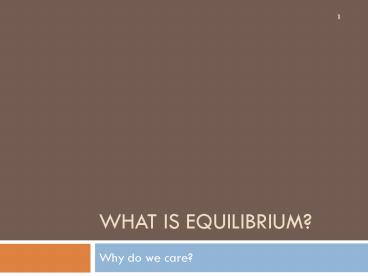What is Equilibrium? - PowerPoint PPT Presentation
1 / 18
Title:
What is Equilibrium?
Description:
Heterogeneous Equilibria. 16 ... reactants or products are in a different phase, the equilibrium is heterogeneous. ... Heterogeneous Equilibria. 17 ... – PowerPoint PPT presentation
Number of Views:16
Avg rating:3.0/5.0
Title: What is Equilibrium?
1
What is Equilibrium?
- Why do we care?
2
Definitions
- Kinetics
- Forward rate reverse rate
- Thermodynamics
- System at lowest energy
- Applications
- Controlling the amount of product
3
Equilibrium (in general)
- Weve already discussed equilibrium when
- talking about reactions.
- In principle, every chemical reaction is
reversible ... - that is, capable of moving the forward or reverse
- direction
- Some reactions are easily reversed...others not
so - much
4
Equilibrium extent of a reaction
- In stoichiometry, we discuss theoretical yields,
and the numerous reasons that actual yields are
lower. - Another critical reason that yields are lower is
- that reactions are reversible some reactions
will - only produce 60 of the product you may
- calculate they ought to produce.
- Equilibrium looks at the extent of a chemical
- reaction.
5
What do we need to learn?
- To understand the equilibrium state
- Value of equilibrium information
6
How can we describe equilibrium mathematically?
- Law of mass action (expression)
- Q Products / Reactants
- Q is the reaction Quotient
Q gt K the system shifts left (reactants)
Q lt K the system shifts right (products)
7
Concept of Equilibrium
- Consider colorless frozen N2O4. At room
temperature, it decomposes to brown NO2 - N2O4(g) ? 2NO2(g).
- At some time, the color stops changing and we
have a mixture of N2O4 and NO2. - Chemical equilibrium is the point at which the
rate of the forward reaction is equal to the rate
of the reverse reaction. At that point, the
concentrations of all species are constant. - Using the collision model
- as the amount of NO2 builds up, there is a chance
that two NO2 molecules will collide to form N2O4.
- At the beginning of the reaction, there is no NO2
so the reverse reaction (2NO2(g) ? N2O4(g)) does
not occur.
8
Concept of Equilibrium
- As the substance warms it begins to decompose
- N2O4(g) ? 2NO2(g)
- When enough NO2 is formed, it can react to form
N2O4 - 2NO2(g) ? N2O4(g).
- At equilibrium, as much N2O4 reacts to form NO2
as NO2 reacts to re-form N2O4 - The double arrow implies the process is dynamic.
9
The concept of equilibrium
- As the reaction progresses
- A decreases to a constant,
- B increases from zero to a constant.
- When A and B are constant, equilibrium is
achieved.
Video
10
Equilibrium Constant
- No matter the starting composition of the
reactants and products, the same ratio of
concentrations is achieved at equilibrium - For a general reaction
- The equilibrium expression is
11
Equilibrium Expression
- Write the equilibrium expression for the
following reaction
12
Equilibrium Expression (Pressure)
- If Kp is the equilibrium constant for reactions
involving gases, then we can write - Kp is based on partial pressures measured in
- atmospheres.
13
Magnitude of the Equilibrium Constant
- A larger value of K means that more products
are present at equilibrium. - The smaller the value of K, the more reactants
are present at equilibrium. - If Kgtgt1, then products dominate at equilibrium
and equilibrium lies to the right. - If Kltlt1, then reactants dominate at equilibrium
and equilibrium lies to the left.
14
Equilibrium Constants and Reversible Reactions
- Magnitude of the Equilibrium Constant
- An equilibrium can be approached from either
direction - Example
15
Reversible Reactions
- Magnitude of the Equilibrium Constant
- A reversible reactions K is 1/K for the forward
reaction - So,
- The K for a reaction in one direction is
- equal to the reciprocal of the K of the
- reaction in the opposite direction.
16
Heterogeneous Equilibria
- When all reactants and products are in one phase,
the equilibrium is homogeneous. - If one or more reactants or products are in a
different phase, the equilibrium is
heterogeneous. - Consider
- experimentally, the amount of CO2 does not seem
to depend on the amounts of CaO and CaCO3. Why?
17
Heterogeneous Equilibria
18
Heterogeneous Equilibria
- Neither density nor molar mass is a variable, the
concentrations of solids and pure liquids are
constant. (You cant find the concentration of
something that isnt a solution!) - We ignore the concentrations of pure liquids and
pure solids in equilibrium constant expressions. - The amount of CO2 formed will not depend greatly
on the amounts of CaO and CaCO3 present.
Kc CO2































